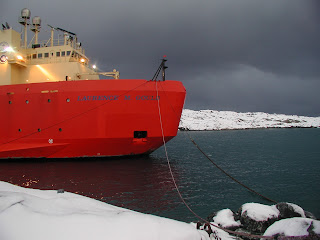On November 18th, the Chilean Navy Lautaro ship came to visit. This particular ship services the chilean stations on the Antarctic Peninsula and is also part of the rescue team if needed in the peninsula area. They are on constant patrol.
The Chileans and also the Argentine vessels like to stop by and have an exchange of personnel. Some of their crew get to come ashore and some of us get to go out for tours on their ships. This ship is a tender called the Lautaro. They've visited us many times in the past years, but the weather had been too bad for us to be able to go on board.
Their crew was able to come on station and get a regular tour that we give all visitors. We take them up to the Bar where we serve tea and cookies and our famous brownies the cooks make.
This particular sailor saw a picture of a picture of another chilean boat called the "Almirante Viel" that visited us in 1999, He said his uncle had given the picture to Palmer Station at that time. Here's a closer picture of it below...
We head out to the Lautaro as they invited us for a B.B.Q. on board their ship.
Here we are getting close to the ship. It's not far from our station, only about 1/2 mile.
We pull up to the stern of the ship and tie off our zodiac and are immediately greeted with a tour and meat being grilled out on their deck.
They served us wine spritzers with fruit and every kind of meat grilled to perfection.
We were able to go on a tour of the ship, up to the bridge...
Then down to see the Captain's cabin. The captain is seated to the left, then Bob Farrell our station manager and Dr. Liz our station doctor.
This is out on the deck making the most of the spanish Liz and I have between us, we had a nice conversation with the crew.
The cooks!
We had a fabulous time and are hoping they get to visit us again soon!






















































